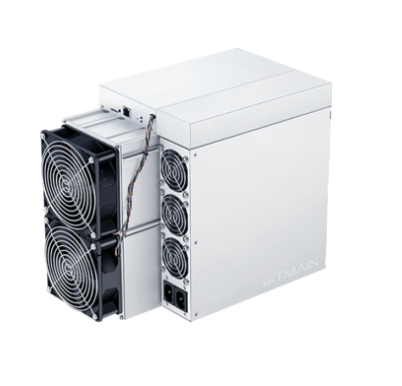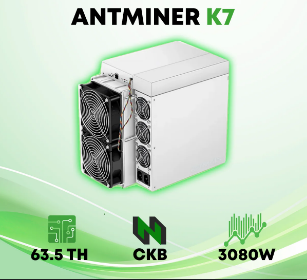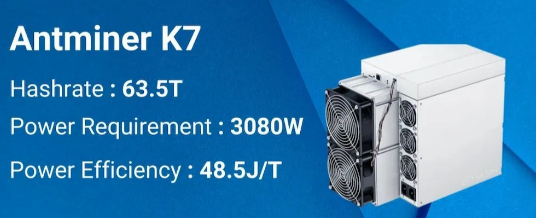How to Calculate Profitability with the CKB Miner K7
Cryptocurrency mining has evolved into a highly competitive and technical industry, where profitability hinges on selecting the right equipment and optimizing operations. For miners focusing on the Eaglesong algorithm—the backbone of the CKB (Nervos Network) cryptocurrency—the CKB Miner K7 by Bitmain stands out as a top-tier solution. This article delves into the features of the K7 and provides a practical guide to calculating its profitability, ensuring miners can make informed decisions and maximize their returns.
Introducing the CKB Miner K7
The CKB Miner K7 is a state-of-the-art mining device engineered specifically for the Eaglesong algorithm. Developed by Bitmain, a global leader in mining hardware, the K7 combines exceptional performance, energy efficiency, and durability, making it an ideal choice for both novice and experienced miners.
At its core, the K7 is powered by 276 advanced hash chips distributed across three hash boards, delivering a typical hashrate of 63.5 TH/s (±3%). This robust performance is complemented by its energy-efficient design, consuming just 3080W (±5%) and achieving a power efficiency of 48.5 J/TH at an ambient temperature of 25°C. Such efficiency translates to lower electricity costs, a critical factor in maintaining profitability in today’s energy-conscious mining environment.
The K7’s compact dimensions (430 x 195.5 x 290mm) and dual AC input design (200-240V, 50-60Hz) make it versatile for deployment in various mining setups, from small-scale operations to large-scale facilities. Its Ethernet connectivity ensures seamless integration into existing network infrastructures, while its durable construction and advanced cooling system ensure reliable performance even in challenging conditions.
Advantages of the CKB Miner K7
The CKB Miner K7 offers several key advantages that set it apart from competitors and enhance its appeal to miners:
- Industry-Leading Performance: With a hashrate of 63.5 TH/s, the K7 is one of the most powerful CKB miners available, enabling miners to maximize their rewards.
- Energy Efficiency: The K7’s power efficiency of 48.5 J/TH helps reduce operational costs, making it a sustainable choice for long-term mining.
- Reliability and Durability: Built by Bitmain, the K7 benefits from rigorous quality control and advanced manufacturing processes, ensuring consistent performance and longevity.
- Future-Proof Investment: By focusing on the Eaglesong algorithm and CKB cryptocurrency, the K7 positions miners to capitalize on the potential growth of this emerging digital asset.
- Modular Design: The K7’s modular components make it easy to replace damaged parts, minimizing downtime and maintenance costs.
- Comprehensive Support: Bitmain offers a 180-day warranty, covering shipping costs for replacement units within the warranty period, providing peace of mind for miners.
Calculating Profitability with the CKB Miner K7
To determine whether the CKB Miner K7 is a profitable investment, miners must consider several factors, including hashrate, power consumption, electricity costs, and current CKB market conditions. Here’s a step-by-step guide to calculating profitability:
1. Understand the Key Metrics
- Hashrate (63.5 TH/s): This measures the miner’s computational power. A higher hashrate increases the likelihood of solving blocks and earning rewards.
- Power Consumption (3080W): This indicates the miner’s energy usage. Lower consumption reduces electricity costs.
- Power Efficiency (48.5 J/TH): This metric shows how efficiently the miner converts energy into hashing power. A lower value is better.
- Electricity Cost ($/kWh): This is the price you pay for electricity, which varies by location.
- CKB Price ($): The current market value of CKB tokens.
- Network Difficulty: This measures how hard it is to mine CKB. Higher difficulty reduces individual miner rewards.
2. Gather Current Data
Before calculating profitability, gather up-to-date information:
- CKB Price: Check reputable exchanges like Binance or CoinGecko.
- Network Hashrate and Difficulty: Use CKB blockchain explorers or mining calculators.
- Electricity Cost: Check your utility bill or local rates.
3. Use a Mining Profitability Calculator
Online tools like WhatToMine or CryptoCompare simplify profitability calculations. Here’s how to use them:
- Select the Eaglesong algorithm.
- Enter the K7’s hashrate (63.5 TH/s) and power consumption (3080W).
- Input your electricity cost ($/kWh).
- The calculator will estimate daily, monthly, and annual earnings, factoring in network difficulty and CKB price.
4. Perform Manual Calculations
For a more detailed analysis, miners can perform manual calculations:

#### Daily Revenue
- Calculate the miner’s share of the network hashrate:
\[ \text{Share} = \frac{\text{K7 Hashrate}}{\text{Network Hashrate}} \]
- Multiply the share by the daily block reward (currently 1,344,000 CKB):
\[ \text{Daily Revenue (CKB)} = \text{Share} \times \text{Block Reward} \]
- Convert CKB to USD using the current price:
\[ \text{Daily Revenue (USD)} = \text{Daily Revenue (CKB)} \times \text{CKB Price} \]
#### Daily Expenses
- Calculate daily electricity consumption:
\[ \text{Daily Consumption (kWh)} = \frac{\text{Power Consumption}}{1000} \times 24 \]
- Multiply consumption by electricity cost:
\[ \text{Daily Cost (USD)} = \text{Daily Consumption} \times \text{Electricity Cost} \]
#### Daily Profit \[ \text{Daily Profit (USD)} = \text{Daily Revenue} – \text{Daily Cost} \]

5. Factor in Additional Costs
Beyond electricity, miners should consider:

- Hardware Costs: The upfront investment in the K7.
- Maintenance: Regular upkeep and potential part replacements.
- Cooling: Additional energy for cooling systems in hot climates.
- Pool Fees: If mining in a pool, account for pool fees (typically 1-2%).
6. Monitor Market Conditions
Cryptocurrency markets are highly volatile. Regularly monitor CKB price, network difficulty, and electricity costs to adjust your profitability calculations.
Practical Example
Let’s assume:

- CKB Price: $0.01
- Network Hashrate: 1,000,000 TH/s
- Electricity Cost: $0.10/kWh
#### Daily Revenue \[ \text{Share} = \frac{63.5}{1,000,000} = 0.0000635 \] \[ \text{Daily Revenue (CKB)} = 0.0000635 \times 1,344,000 = 85.344 \text{ CKB} \] \[ \text{Daily Revenue (USD)} = 85.344 \times 0.01 = \$0.853 \]
#### Daily Expenses \[ \text{Daily Consumption} = \frac{3080}{1000} \times 24 = 73.92 \text{ kWh} \] \[ \text{Daily Cost} = 73.92 \times 0.10 = \$7.392 \]
#### Daily Profit \[ \$0.853 – \$7.392 = -\$6.539 \]
In this scenario, the K7 is not profitable. However, if electricity costs drop to $0.05/kWh or the CKB price rises to $0.02, profitability improves significantly.
Conclusion
The CKB Miner K7 is a powerful and efficient mining solution for the Eaglesong algorithm, offering miners the potential to maximize their returns. However, profitability depends on careful calculation of key metrics and ongoing monitoring of market conditions. By leveraging tools and techniques outlined in this guide, miners can make informed decisions and optimize their operations for long-term success. Whether you’re a seasoned miner or just starting out, the K7 represents a compelling investment in the future of CKB mining.